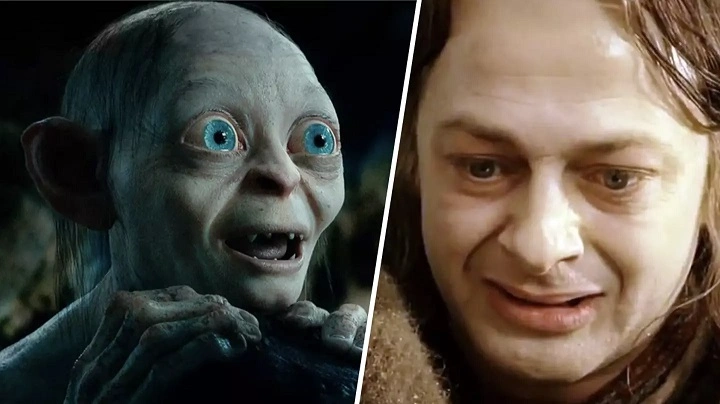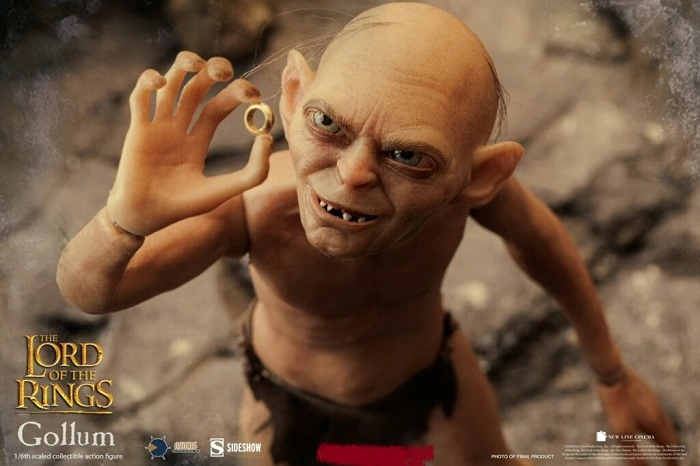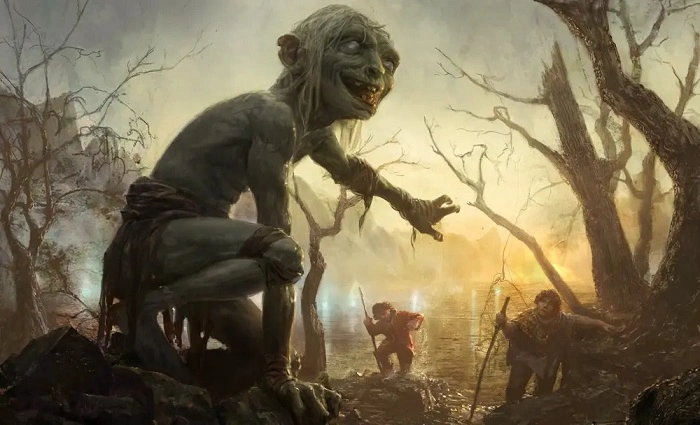There is a whisper that echoes through the fantasy genre, a choked, guttural sound obsessed with a single object: “My Precious.” It’s the sound of Gollum, the wretched creature of the dark. But beneath that monster is the ghost of someone else entirely—a Hobbit-like soul named Sméagol. Their story is one of the most compelling and heartbreaking tales of corruption and lost identity in all of literature.
This article explores the complete journey of Sméagol, from his innocent beginnings to his tragic end at the Crack of Doom. We will delve deep into his fractured psyche, analyze the profound difference between the Sméagol and Gollum personalities, and understand why his story is central to the fate of Middle-earth. This is the definitive guide for both newcomers to The Lord of the Rings and die-hard Tolkien fans seeking a deeper understanding of the character.
Who Was Sméagol Before the Ring? The Forgotten Hobbit
Long before the darkness took him, Sméagol was a member of the Stoor branch of Hobbits. He lived with his extended family under a matriarch, his grandmother, in a burrow near the Gladden Fields. These Stoors were a riverside folk, and Sméagol was no exception. He was known for his curiosity, often delving into tunnels and digging under things, earning him a reputation for being a bit of a snoot.
While perhaps a loner and perceived as slightly odd, Sméagol was not inherently evil. He enjoyed simple pleasures like fishing and the quiet of the riverbank. His life was unremarkable, defined by the peaceful, pastoral existence shared by his kin—an existence that would be irrevocably shattered by a glint of gold in the water.
The Fateful Birthday and the Murder of Déagol
The turning point of Sméagol’s life—and a pivotal moment for all of Middle-earth—came on his birthday. He was fishing in the river with his cousin, Déagol, when Déagol was pulled underwater by a great fish. There, in the riverbed, he found a beautiful golden ring. Upon surfacing, Déagol held the ring in his palm, and the One Ring immediately began to exert its will.
Sméagol, seeing the Ring, was instantly ensnared by its beauty and power. He demanded it, claiming it was his birthday. “Give us that, Déagol, my love,” said Sméagol. “Because it’s my birthday.” When Déagol refused, the Ring’s influence overwhelmed Sméagol’s mind. In a fit of murderous greed, he strangled his cousin and hid the body. This horrific act was his point of no return. The Ring was his, but his life was now forfeit. His family, using the Ring’s invisibility against him and shunning his increasingly malicious behavior, nicknamed him “Gollum” for the horrible swallowing sound he made in his throat. They cast him out, and he was forced to wander alone.
The Transformation: How Sméagol Became Gollum
The One Ring‘s power is not merely one of invisibility; it is a profoundly corrupting force that poisons the mind, body, and soul. It fed on Sméagol’s weakness, his guilt, and his growing paranoia, twisting him over centuries into a new, wretched creature.
His long, lonely journey led him away from the sun, which he began to hate, and deep into the cold, dark caves beneath the Misty Mountains. There, in utter blackness, the final transformation took hold.
The Physical Toll: A Body Warped by Darkness
Over 500 years, the Ring’s influence and the sunless environment physically decayed Sméagol.
- His skin grew pale, clammy, and black.
- His body became emaciated and gaunt, yet his limbs remained strong and wiry from climbing and catching fish.
- His eyes grew large, luminous, and lamp-like to see in the gloom, becoming sensitive to any bright light.
- He developed his signature guttural swallowing noise, the very sound that earned him his new name: Gollum.
The Psychological Fracture: A Mind Divided
The most profound damage was to his mind. To cope with the unbearable loneliness and the guilt of murdering Déagol, his psyche fractured. The Gollum personality was born—a manifestation of his darkest impulses. It was cruel, hateful, and obsessed only with the Ring, which he called My Precious. Gollum blamed others for his misery and reveled in thoughts of murder and deceit.
Yet, deep within, the original Sméagol personality survived. This faint echo clung to the fragmented memories of his past life: the sun, the wind, the taste of fish, and the concept of friendship. This internal war between Sméagol and Gollum would define his existence for the rest of his life.
Sméagol vs. Gollum: The Definitive Breakdown
Understanding the duality of the character is essential. To directly address the Smeagol vs Gollum query, here is a clear comparison of the two warring personalities.
| Feature | Sméagol Personality | Gollum Personality |
| Core Drive | Yearning for friendship, peace, simple pleasures (fish) | All-consuming obsession with the Ring (“Precious”) |
| Speech Pattern | Uses “I,” “we” (referring to himself and [[Frodo Baggins]]) | Uses “we,” “us” (referring to himself and the Ring), hisses |
| Morality | Retains a sliver of conscience, capable of loyalty and pity | Utterly ruthless, treacherous, driven by murder and deceit |
| Relationship to Others | Seeks approval ([[Frodo Baggins]]), fears punishment ([[Samwise Gamgee]]) | Views others as obstacles or tools to regain the Ring |
Sméagol’s Journey Through Middle-earth
After centuries in darkness, Gollum was unwillingly drawn back into the great events of his time, first by a Hobbit who got lost and later by that Hobbit’s nephew.
Encounters in The Hobbit
In The Hobbit, it is the Gollum personality that is fully dominant when he encounters [[Bilbo Baggins]]. Living on a dark island in a subterranean lake, Gollum is a menacing figure who intends to eat Bilbo. His proposal of a riddle game is merely a cruel way to play with his food. When Bilbo wins the game and escapes using the very Ring Gollum had lost, Gollum’s rage and despair send him out of the mountains in a desperate search for his “Precious.”
The Guiding Hand in The Lord of the Rings
Years later, Gollum’s path crosses with [[Frodo Baggins]] and [[Samwise Gamgee]]. After being captured, something remarkable happens. Frodo, seeing the wretched state of this creature, shows him pity. This act of kindness reaches the buried Sméagol personality, who has not felt such compassion in centuries.
For a time, Sméagol re-emerges. He swears on the “Precious” to serve the master of the Ring and guides the Hobbits toward Mordor. The internal debates between Sméagol and Gollum, brilliantly depicted in both the book and films, become a central conflict. Sméagol wants to help his “nice master,” while Gollum plots to kill the Hobbits and take the Ring.
The turning point for his betrayal comes at the Forbidden Pool. After being interrogated by [[Faramir]], Sméagol feels betrayed by Frodo, believing his master has given him up to his enemies. This, combined with Sam’s constant suspicion, allows the hateful Gollum personality to regain full control, leading him to guide the Hobbits into the trap of the spider Shelob at Cirith Ungol.
The Climax: Redemption, Tragedy, and a Final Act of Fate
The final confrontation takes place at the Sammath Naur, the Crack of Doom. As Frodo stands on the precipice, he finally succumbs to the Ring’s power and claims it for himself. All hope seems lost.
At that moment, Gollum attacks. In a desperate struggle, he bites the Ring from Frodo’s finger. This is his ultimate triumph, the moment he has dreamed of for decades. Holding his Precious aloft, he shrieks with joy, but in his ecstasy, he loses his footing and tumbles into the fiery chasm below.
Was this final act pure greed or a fated intervention necessary to destroy the Ring? The answer is both. Gollum’s personal tragedy becomes the unlikely salvation of Middle-earth. His all-consuming addiction, the very thing that destroyed him, is what ultimately destroys the Ring itself. In the moment of his greatest victory, he meets his end and, unintentionally, fulfills the quest.
Beyond the Page: Andy Serkis’s Definitive Performance
It is impossible to discuss Sméagol’s cultural impact without acknowledging Peter Jackson’s film trilogy and the revolutionary performance by Andy Serkis. Using motion-capture technology, Serkis brought the character’s internal conflict to life in a way that was groundbreaking for cinema.
His ability to shift his voice from Sméagol’s pathetic, lisping plea to Gollum’s menacing hiss, combined with the contorted, agonizing physicality he developed, gave audiences a visceral understanding of the war raging within one body. Serkis’s performance cemented Sméagol/Gollum as one of cinema’s most unforgettable characters.
The Thematic Importance of Sméagol
Sméagol is far more than just a creature or a villain. He is a profound symbol of several key themes in Tolkien’s legendarium.
- The Power of Pity and Mercy: Gandalf tells Frodo that his heart tells him Gollum has some part to play, for good or ill. Frodo’s pity is Sméagol’s only chance at redemption and is the very thing that allows the quest to succeed. It’s a powerful statement that mercy is not weakness.
- Addiction and Corruption: Sméagol’s relationship with the Ring is one of the most powerful allegories for addiction ever written. It shows how an obsession can consume one’s identity, destroy relationships, and lead to a living death.
- The Duality of Good and Evil: Sméagol is the walking embodiment of the idea that good and evil are not absolutes but a constant struggle within a single soul. He is a stark warning of what the Ring can do, a terrifying reflection of what Frodo himself could become.
Frequently Asked Questions (FAQ) About Sméagol
What is the difference between Sméagol and Gollum?
Sméagol was the original Hobbit-like person, who was curious but not evil. Gollum is the monstrous, hateful personality that developed after he murdered his cousin for the One Ring and became obsessed with it. Sméagol represents his past self, while Gollum represents his corruption.
How did Sméagol die?
He died by falling into the fires of [[Mount Doom]]. After biting the One Ring from Frodo’s finger at the Crack of Doom, he lost his balance in a moment of crazed joy and fell into the lava, destroying both himself and the Ring.
Why did Frodo trust Sméagol?
Frodo trusted Sméagol out of pity. He saw in Sméagol a reflection of what the Ring could do to any Hobbit, including himself. He felt a bond of shared burden and believed that showing mercy offered the only hope for Sméagol’s redemption.
What were Sméagol’s last words?
His last word, shrieked in a mix of triumph and agony as he fell into [[Mount Doom]], was “Precious!”
Was Sméagol truly evil?
This is a complex question. Sméagol committed evil acts under the profound, corrupting influence of the One Ring. However, the core Sméagol personality was a tragic figure, not a purely evil one. He retained a capacity for loyalty and remorse, making his story a tragedy of a good person destroyed by an evil power, rather than the story of a simple monster.
Sméagol is not just a monster lurking in the dark; he is one of literature’s most complex, tragic, and essential characters. His story is a harrowing journey from innocence to monstrosity, a living portrait of a mind at war with itself. He serves as a constant, terrifying warning of the Ring’s ultimate power, but also as an unlikely testament to the enduring strength of pity and hope. In the end, the wretched creature cast out by his family became the instrument of salvation for all of Middle-earth, forever binding his tragedy to its triumph.




